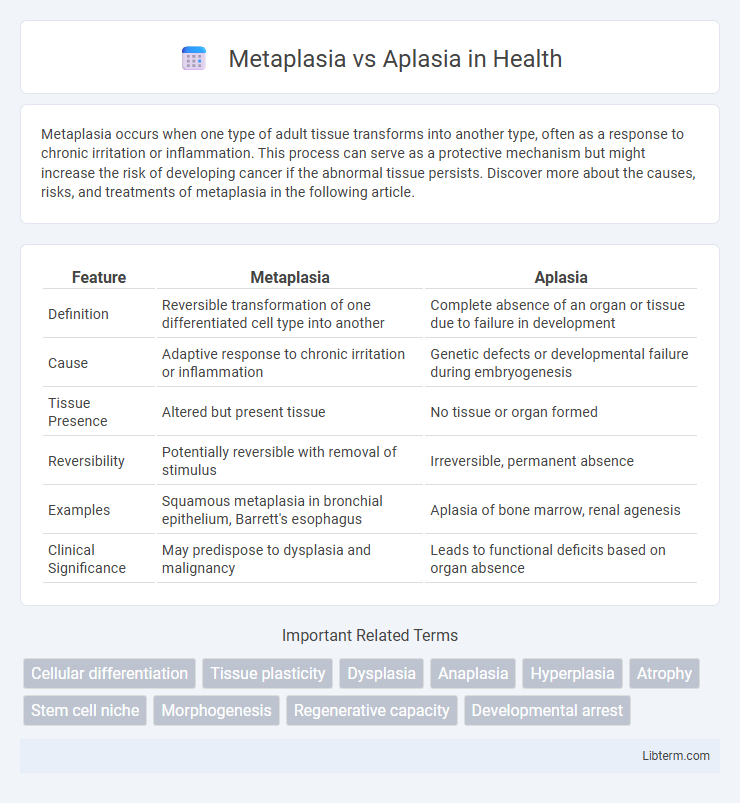Metaplasia occurs when one type of adult tissue transforms into another type, often as a response to chronic irritation or inflammation. This process can serve as a protective mechanism but might increase the risk of developing cancer if the abnormal tissue persists. Discover more about the causes, risks, and treatments of metaplasia in the following article.
Table of Comparison
| Feature | Metaplasia | Aplasia |
|---|---|---|
| Definition | Reversible transformation of one differentiated cell type into another | Complete absence of an organ or tissue due to failure in development |
| Cause | Adaptive response to chronic irritation or inflammation | Genetic defects or developmental failure during embryogenesis |
| Tissue Presence | Altered but present tissue | No tissue or organ formed |
| Reversibility | Potentially reversible with removal of stimulus | Irreversible, permanent absence |
| Examples | Squamous metaplasia in bronchial epithelium, Barrett's esophagus | Aplasia of bone marrow, renal agenesis |
| Clinical Significance | May predispose to dysplasia and malignancy | Leads to functional deficits based on organ absence |
Introduction to Metaplasia and Aplasia
Metaplasia is a reversible cellular adaptation where one differentiated cell type changes into another, often in response to chronic irritation or inflammation, as seen in the respiratory epithelium of smokers. Aplasia refers to the complete failure of an organ or tissue to develop during embryogenesis, resulting in the absence of that structure, commonly observed in conditions such as renal or thymic aplasia. Understanding metaplasia and aplasia is essential in pathology to distinguish between adaptive cellular changes and congenital malformations.
Defining Metaplasia: An Overview
Metaplasia is the reversible transformation of one differentiated cell type into another, usually as an adaptive response to chronic irritation or inflammation. This cellular adaptation allows tissues to better withstand environmental stress but may predispose to dysplasia or malignancy if persistent. Unlike aplasia, which denotes the complete absence of an organ or tissue due to developmental failure, metaplasia involves a phenotypic change in existing cells.
Understanding Aplasia: Key Concepts
Aplasia is the complete absence or failure in the development of an organ or tissue, resulting from the lack of progenitor cells during embryogenesis. Unlike metaplasia, which involves the adaptive transformation of one differentiated cell type into another, aplasia signifies a congenital defect characterized by missing structures essential for normal function. Understanding aplasia requires recognizing its impact on organ system development and potential clinical manifestations stemming from the absence of functional tissue.
Causes and Risk Factors of Metaplasia
Metaplasia occurs due to chronic irritation, inflammation, or exposure to harmful stimuli such as tobacco smoke, acid reflux, or vitamin A deficiency, which trigger adaptive cellular changes. Risk factors for metaplasia include smoking, gastroesophageal reflux disease (GERD), chronic infections, and environmental toxins that promote abnormal differentiation of epithelial tissues. Unlike aplasia, which is a congenital absence of an organ or tissue due to developmental failure, metaplasia represents a reversible transformation induced by adverse external conditions.
Etiological Factors Leading to Aplasia
Aplasia results from severe disruptions in embryonic development caused by genetic mutations, compromised blood supply, or teratogenic exposures during organogenesis. Key etiological factors include chromosomal abnormalities, maternal infections such as rubella, and exposure to harmful environmental agents like radiation and certain drugs. Unlike metaplasia, which involves adaptive cellular changes, aplasia reflects the complete failure of an organ or tissue to develop.
Cellular and Molecular Mechanisms Involved
Metaplasia involves the reversible transformation of one differentiated cell type into another due to chronic irritation or inflammation, driven by epigenetic reprogramming and altered transcription factor expression such as SOX2 and p63. Aplasia, in contrast, results from the failure of cellular proliferation and differentiation during embryogenesis, often linked to genetic mutations affecting signaling pathways like WNT, BMP, and SHH. Molecular mechanisms in metaplasia center on the dynamic regulation of gene expression controlling cell phenotype, whereas aplasia is characterized by arrested tissue development due to disrupted progenitor cell function.
Clinical Manifestations and Diagnostic Criteria
Metaplasia presents with altered tissue architecture where one differentiated cell type is replaced by another, often resulting in symptoms related to the affected organ such as cough or dysphagia in Barrett's esophagus. Aplasia is characterized by the complete absence of an organ or tissue, typically detected through developmental anomalies or failure of function, evident in conditions like renal or bone marrow aplasia. Diagnostic criteria for metaplasia rely on histological examination showing replacement of normal epithelium, while aplasia is diagnosed via imaging and functional tests confirming the absence or severe hypoplasia of the organ or tissue.
Differences Between Metaplasia and Aplasia
Metaplasia is a reversible change where one differentiated cell type is replaced by another, often as an adaptive response to chronic irritation, while aplasia is a congenital absence or failure of an organ or tissue to develop. Metaplasia involves cellular transformation and adaptation, whereas aplasia reflects a developmental defect with lack of tissue formation. Metaplasia can potentially progress to dysplasia or neoplasia if the stimulus persists, but aplasia results from interrupted embryonic development without tissue presence.
Treatment Approaches and Prognosis
Treatment approaches for metaplasia primarily involve addressing the underlying cause, such as eliminating exposure to irritants or managing chronic inflammation, which can often lead to reversal if caught early. Aplasia, characterized by the absence of tissue development, typically requires more complex interventions, potentially including surgical reconstruction or supportive therapies, as spontaneous recovery is rare. Prognosis for metaplasia is generally favorable with early intervention, whereas aplasia prognosis depends on the affected organ and extent of tissue absence, often necessitating long-term management.
Future Research and Emerging Therapies
Future research on metaplasia aims to identify molecular pathways driving abnormal cellular reprogramming to develop targeted therapies that prevent progression to malignancy. In contrast, emerging therapies for aplasia focus on stem cell transplantation and gene editing techniques to restore or replace absent or underdeveloped tissues. Advances in regenerative medicine and precision oncology provide promising avenues for addressing both conditions at the cellular and genetic levels.
Metaplasia Infographic

 libterm.com
libterm.com